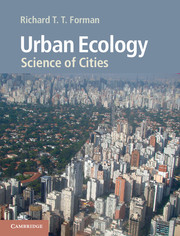Book contents
- Frontmatter
- Dedication
- Contents
- Foreword
- Preface
- Acknowledgments
- Part I Framework
- Part II Ecological features
- Part III Urban features
- 10 Human structures
- 11 Residential, commercial, industrial areas
- 12 Green spaces, corridors, systems
- Epilogue
- Appendix A Positive and negative attributes of an urban region
- Appendix B Equations
- References
- Index
12 - Green spaces, corridors, systems
Published online by Cambridge University Press: 05 June 2014
- Frontmatter
- Dedication
- Contents
- Foreword
- Preface
- Acknowledgments
- Part I Framework
- Part II Ecological features
- Part III Urban features
- 10 Human structures
- 11 Residential, commercial, industrial areas
- 12 Green spaces, corridors, systems
- Epilogue
- Appendix A Positive and negative attributes of an urban region
- Appendix B Equations
- References
- Index
Summary
One might consider an ideal series of parks as you might a great water system, using the metaphor of green water … a weaving, interconnected green mass that changes in size and purpose, but always inter-penetrates forcibly but gently the urban, suburban, and rural scene.
William M. Roth, Conservation Foundation symposium, Washington, D.C., 1971Rio has edged in between the hills and the sea … But the jungle is still there. You can reach it easily by tram, or through suburban backdoors.
Peter Fleming, Brazilian Adventure, 1933Is there a better dream than the glorious life of a songbird, gliding over the land from tree to tree, diving into flower gardens, splashing in a pool, and joining hundreds in a chorus with scores of parts? Home may be the luxuriant tropics where life is always sunny. Your ancestors gave you genes for the marathon, when you migrate to foreign land with an explosion of delicious insects or seeds, nice for raising babies. After several nights of flying, an inhospitable metro area stretching to the horizon appears beneath you. But look, a large green patch ahead … and tired wings thankfully carry you there for rest and food (Figure 12.1). While foraging, you meet an unknown relative who grew up in forest beyond the city. The local bird reached your greenspace by moving along a wonderfully wide green corridor, connecting natural land to city center.
Many types of large greenspaces and major green vegetated corridors are introduced in this chapter. The vegetation within them appears in six general forms (Dorney and McClellan, 1984; Kot, 1988; Godde et al., 1995; Rieley and Page, 1995; Breuste, 2009). Examples of each are listed:
Woods: woodland, forest, natural, semi-natural, remnant, regenerated, all normally containing litter, herbaceous, and shrub layers.
Lawn with trees: cemetery, golf course, city park, playing field area, and plaza, most containing ornamentals, shrubs, dispersed trees, and flower gardens.
Urban agriculture: crops/cultivation, paddy, pasture, orchard/vineyard, and community garden.
Wetland: freshwater or saltwater mudflat, marsh, swamp.
Successional habitat: meadow, edge of dump, former farm field, former quarry, vacant plot, brownfield.
Combination of the preceding types: considerable habitat diversity, and often the most common form of greenspace vegetation.
- Type
- Chapter
- Information
- Urban EcologyScience of Cities, pp. 343 - 371Publisher: Cambridge University PressPrint publication year: 2014
- 1
- Cited by



